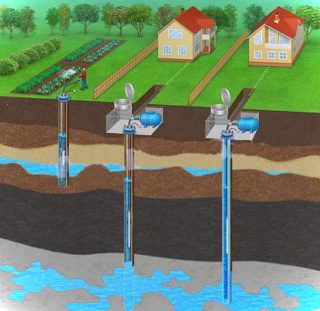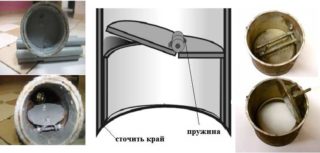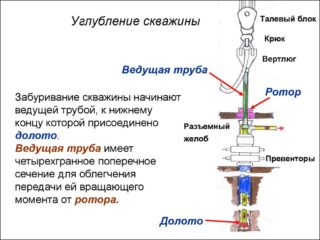It often happens that a natural source of sand or limestone loses its flow rate after long-term operation. Many craftsmen decide to drill an old well, rather than make a new one. How expedient this option is, is determined by several parameters - the complexity of the work to be done, the root cause of the decrease in the water level in the source.
Reasons for the disappearance of water in the well

To make sure that the water level in the well is constantly decreasing, you need to watch it. Perhaps this is a temporary problem, provoked by the characteristics of the aquifer or the weather conditions in the region. It is not out of place to talk to your neighbors and find out how things are with their sources. If the problem arose only with a specific well, then we are talking about the depletion of the resource.
The main reasons for the drop in the water level in the well:
- clogging of the bottom filter, if the source is drilled on a true floater;
- deviation of the shaft from the vertical position, subject to the admission of technical errors at the time of well construction;
- depressurization of the casing;
- a large number of sources in the village, fed from one aquifer (especially the problem of the disappearance of water in a hydraulic structure is noted immediately after drilling a well from a neighbor);
- a long period of summer drought (the problem is typical for sources on the sand);
- construction of a well during a period of high groundwater standing.
It is advisable to drill a well or deepen it in summer or winter.
It is possible to deepen an existing well if its service life is no more than 5-10 years. It is important to weigh the pros and cons of such work. The financial capabilities of the foreman are taken into account (more often deepening the source is more expensive than building a new one), the possibility of building up the casing, the results of geological surveys. It makes no sense to perform work without them, since the next aquifer can be located extremely deep.
Preparation for work
The preparatory stage is important when deepening the well under water. The result of secondary drilling depends on how correctly everything is done. The preparation looks like this:
- retirement fluid is pumped out of the well;
- if at this moment a misalignment of the barrel rings is detected, eliminate the defect if possible. If the displacement is strong, work will have to be stopped on this source;
- all joints of the column are carefully fixed with special plates - this will save the mine from rupture during drilling; the plates are placed at an equal distance from each other;
- prepare a shovel, containers for sand, an electric or hand winch, a drill, a lantern.
All do-it-yourself deepening actions can be carried out only with an Abyssinian source (no more than 5-6 meters deep). In other cases, it will not work to deepen the well without drilling.
Deepening methods
- The source shaft is completely free of liquid residues.
- The casing string is cleaned of silt.
- The bailer is attached to the winch and lowered down into the source.
- From a height of 1-1.5 meters, a metal pipe is thrown so that it crashes into the ground for several centimeters. At the moment of its sharp lowering, the damper opens to take soil from the shaft of the mine.
- When the thief is lifted, the valve closes, preventing the soil from crumbling down.
- On the surface, the pipe is freed from sand and the actions are repeated with a deepening until the result is obtained.
It is advisable to carry out the work together. As soon as the foreman reaches the new aquifer, you need to finish the casing from the bottom. To do this, even on the surface, a section of the mine is collected, with a diameter smaller than the one already available, and lowered down. Then, the two sections of the column are spliced.
The same method is used by specialists with drilling rigs. The difference is that the special equipment functions faster and can deepen the well to a greater length.
Deepening with rings

An old well can be drilled with rings. They also work here as a bailer. To lengthen the casing string, segments of rings or pipes are used that are similar in diameter to those already available. The works look like this:
- The source is deepened with a metal pipe.
- As the depth of the mine increases, new tube lengths are installed on top of the casing. Under their own weight, they lower the existing trunk down. The main thing is to carefully seal the joints of the elements.
- With each new meter of deepening, the well shaft is refined.
After achieving the result, the water from the new horizon should be sent for analysis.
Deepening on quicksand
It is a special type of soil characterized by its constant movement. To properly drill the source, you need to act quickly. For this, a longer bailer should be prepared so that it absorbs more soil. Also, when working on quicksands, you need to use more powerful equipment, since wet soil has an impressive weight.
The finished deepened well is equipped with a filter in the lower part. To do this, take a plastic pipe with a slightly smaller section than the casing. Holes of 3-4 mm are made along its entire surface with a step of 3-5 cm. The outer part of the tube is wrapped with a fine-mesh net. It remains to lower the homemade filter into the lower part of the well and seal up the joints with the main shaft.
The deep source needs to be pumped well.
Frequent mistakes
When performing work, it is important to avoid common mistakes. These are:
- Inaccurately established reason for draining the source If this phenomenon is temporary, at the time of new drilling, the old aquifer can resume its work.
- Carrying out works in the season of high groundwater standing (spring / autumn). Here, the appearance of water while drilling will be false. When groundwater flows down in summer or winter, the liquid from the well will disappear.
- Technological errors, incorrect calculations. This threatens further displacement of the casing sections.
- Lack of expert advice before performing work. It may happen that it is more expedient to drill a new source than to try to resume the work of the old one.
It is not recommended to deepen the well into limestone (artesian) without conducting accurate geological surveys.









